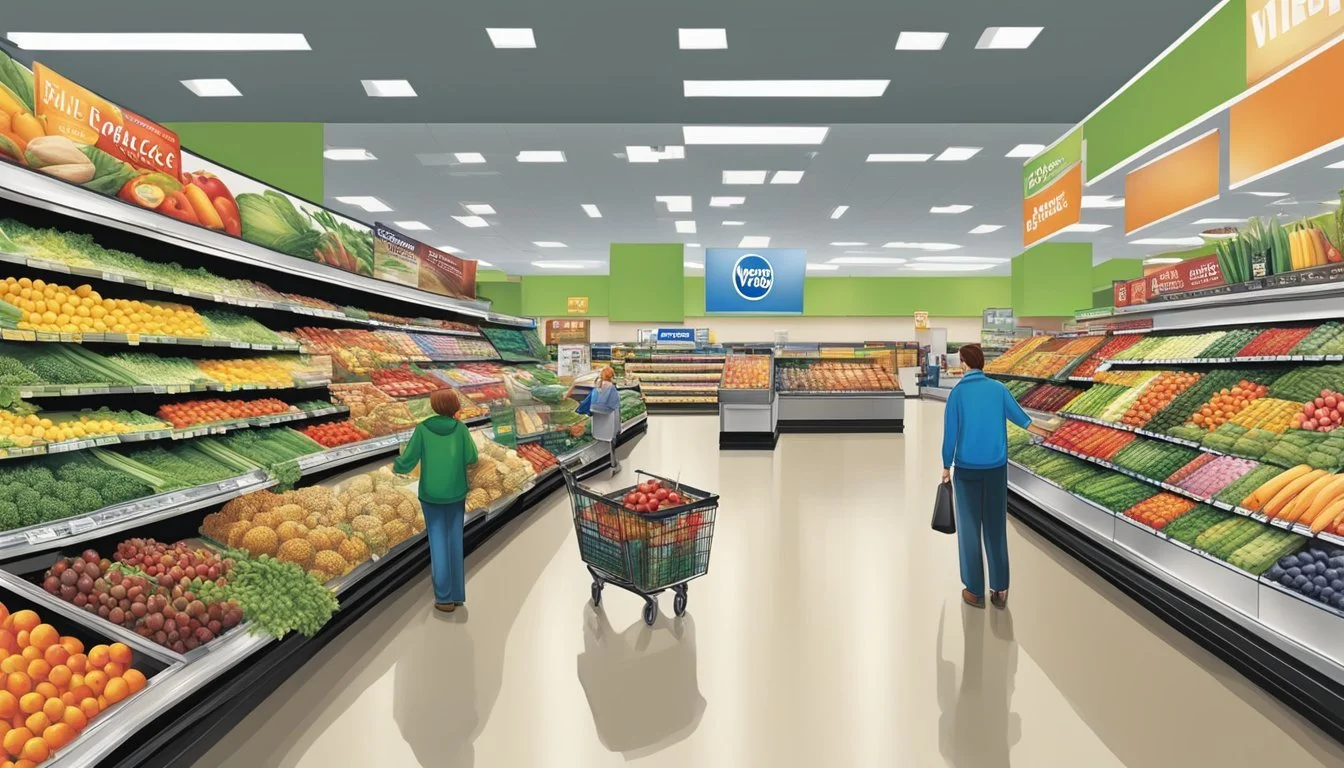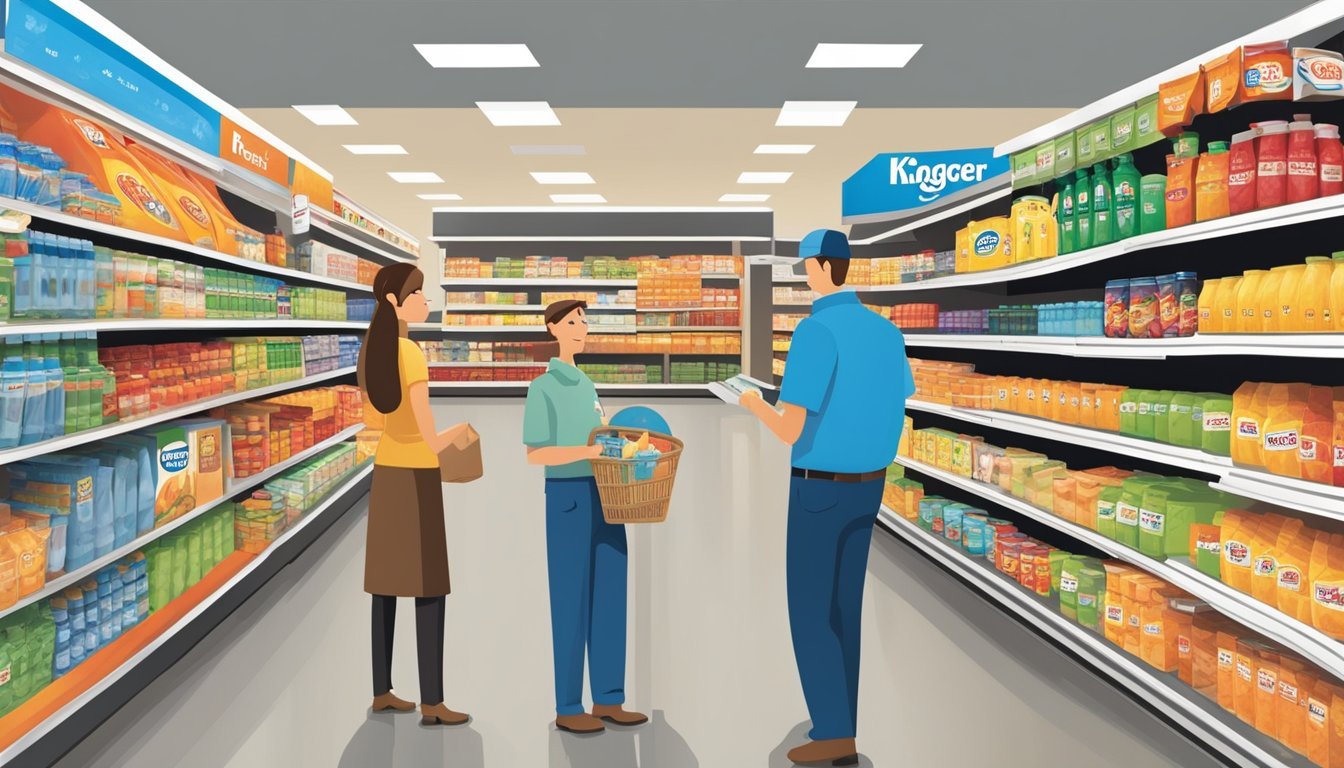Kroger vs Hy-Vee
Comparing Grocery Store Quality, Prices, and Services
In the landscape of American grocery chains, Kroger and Hy-Vee stand out for their size, reach, and customer loyalty. Kroger, one of the country's largest supermarket chains, operates multiple formats ranging from hypermarkets to boutique stores, serving a diverse clientele with a vast array of products. Hy-Vee, while smaller in scale, prides itself on quality and customer service, catering to regional tastes with a strong presence in the Midwest. Each grocery store has carved out a niche for itself, with Kroger known for its extensive store network and Hy-Vee recognized for its community-focused approach.
When analyzing Kroger and Hy-Vee, it is essential to consider various aspects that contribute to a grocery store's overall value - from product pricing and quality to the shopping experience and brand reputation. Kroger offers a wide variety of private-label products that often match national brands in quality while maintaining competitive pricing. In contrast, Hy-Vee has received praise for its fresh produce and quality, though it has seen a dip in excitement around the brand, according to recent consumer reports.
Consumers frequently decide between these grocery giants based on location, product selection, and value for money. Kroger's national footprint makes it a convenient option for many, while Hy-Vee's reputation holds strong in areas where it operates. Both chains have evolved to offer digital shopping solutions and customer loyalty programs, ensuring their relevance in a rapidly changing retail market. How these stores measure up against each other ultimately depends on the specific needs and preferences of the shopper.
Historical Background
In discussing Kroger and Hy-Vee, it is paramount to understand the considerable histories that underpin these grocery chains. Both have seen substantial expansion and transformation over the years, which has cemented their positions as prominent players in the American grocery market.
Founding and Expansion
Kroger began its journey in 1883 when Barney Kroger invested his life savings of $372 to open a grocery store in Cincinnati, Ohio. By 1902, the company had grown to consist of 40 stores. Kroger's expansion continued aggressively, and by 1930, it was operating 5,575 stores.
1883: Kroger's founding in Cincinnati.
1902: Expansion to 40 stores.
1930: Operating 5,575 stores.
Hy-Vee, on the other hand, has a slightly later start. Charles Hyde and David Vredenburg (Hy-Vee is a contraction of their last names) opened a small general store in Beaconsfield, Iowa, in 1930. Since then, Hy-Vee has expanded significantly across the Midwestern United States.
1930: Hy-Vee's first store opens in Beaconsfield, Iowa.
Evolution of Retail Grocery Chains
The evolution of Kroger has been marked by innovation in the supermarket industry. From being one of the first grocery stores to start its own bakery in 1902, to pioneering the superstore concept in 1930, and then forming the first supermarket surrounded by a parking lot in 1934, Kroger has often led the way.
Key Dates for Kroger:
1902: Starts its own bakery.
1930: Pioneers the superstore concept.
1934: Opens the first supermarket with a parking lot.
Hy-Vee has also been a trailblazer, particularly in terms of employee ownership. In 1960, the company became employee-owned. This was a significant evolution in its business model, fostering a unique company culture focused on customer service and employee satisfaction.
Key Dates for Hy-Vee:
1960: Becomes employee-owned.
Throughout their histories, both Kroger and Hy-Vee have expanded their reach and services, reflecting the broader changes in the supermarket industry. From opening new locations, diversifying product offerings to incorporating online shopping, these chains have evolved to meet the changing needs of consumers.
Store Offerings Comparison
When comparing Kroger and Hy-Vee, the focus is on product selection and quality, store brands and exclusives, and the availability of organic and specialty foods. Each store has its own strengths in providing a wide array of options to cater to the diverse needs of customers.
Product Selection and Quality
Kroger boasts an extensive selection of food products, including fresh produce, meat, and pantry staples. They are known for their focus on quality, ensuring that shoppers often find a variety of fresh products. Hy-Vee also offers a wide range of high-quality food items, with an emphasis on providing locally sourced produce and meats when available. Both stores place a significant emphasis on the freshness and quality of their food offerings, aiming to provide consumers with the best possible options.
Store Brands and Exclusives
Kroger operates several store brands, such as Kroger Brand, Private Selection, and Simple Truth, which cover a spectrum from budget-friendly to premium and organic options. These in-house brands offer exclusive products that can't be found elsewhere, often at a lower cost than national brands. Hy-Vee, on the other hand, carries its own exclusive store brands, including Hy-Vee Aisles Online, that cater to a variety of consumer needs, from basic groceries to gourmet and international foods.
Organic and Specialty Foods
Both Kroger and Hy-Vee have responded to the growing demand for organic and specialty foods. Kroger's Simple Truth is one of their most popular organic brands, offering a vast selection that competes with offerings from specialty stores like Whole Foods Market, Fresh Market, and Sprouts Farmers Market. Hy-Vee also embraces the organic trend with a strong assortment of organic produce and packaged goods, as well as a HealthMarket department dedicated to natural and organic products.
Pricing Strategies
When discussing the pricing strategies of Kroger and Hy-Vee, it's essential to consider how each grocery chain approaches everyday prices and discounts, as well as the structure of their membership and loyalty programs. These factors significantly influence consumer choice and determine the overall shopping experience.
Everyday Prices and Discounts
Kroger is recognized for its competitive pricing structures. Their strategy often revolves around providing customers with lower everyday prices on staple items, leveraging their purchasing power to offer discounts that smaller chains may struggle to match.
Discounts: Kroger frequently runs promotions and clearance sales, which can lead to significant savings for the customers.
Price Variation: Kroger's prices may vary by location but are generally known for an overarching strategy that focuses on affordability.
In contrast, Hy-Vee often relies on weekly deals and personalized offers to attract customers.
Dynamic Pricing: Hy-Vee adjusts prices based on market trends and individual store performance.
Discount Offers: The brand may not compete directly with Kroger's everyday low prices but provides value through specific, often temporary, discount offers.
Membership Deals and Loyalty Programs
Kroger's loyalty program plays a critical role in its pricing strategy. With the Kroger Plus Card, customers gain access to member-exclusive discounts and accrue points that can be redeemed for fuel discounts and other savings, encouraging repeat business.
Fuel Rewards: The more customers spend, the more they save on fuel, incentivizing larger or more frequent purchases.
Digital Coupons: Members have access to a wide variety of digital coupons which can be easily loaded onto their loyalty card and applied automatically at checkout.
Hy-Vee also offers a membership program that rewards customers for their loyalty.
Fuel Discounts: Similar to Kroger, Hy-Vee's program includes savings on fuel, although details may vary.
Personalized Offers: Hy-Vee's memberships often come with personalized deals, tailored to customer purchase history and preferences.
Both Kroger and Hy-Vee strive to offer value through their pricing strategies and loyalty programs, albeit with different methods. Kroger appeals to customers looking for consistent low prices and broad discounts, while Hy-Vee focuses more on tailored deals and changing promotions that incentivize specific buying behaviors.
Regional Presence and Expansion
When comparing Kroger and Hy-Vee, examining their strategy for regional presence and expansion provides insight into their dominance and customer reach within the grocery store industry.
National Expansion and Market Presence
Kroger is one of America's largest supermarket chains and anchors its presence with over 2,700 stores nationwide. Its extensive network spreads across multiple states, offering a variety of formats from supermarkets to multi-department stores, with regional brands under its umbrella. Hy-Vee, traditionally concentrated in the Midwest with a strong regional presence, has taken notable steps to expand its footprint. As of the latest expansions, Hy-Vee has branched out into four new states, signaling its intention to compete on a national level.
Kroger's Regional Brands: Include Ralphs, Fred Meyer, Harris Teeter, among others.
Hy-Vee's Expansion: Into Alabama, Tennessee, Indiana, and Kentucky; previously largely confined to the Midwest.
Local Market Penetration
Both Kroger and Hy-Vee exhibit strategic approaches to local market penetration, tailoring their offerings to the needs of the areas they serve. Kroger operates with a local-first mindset, adjusting products and services to align with regional tastes and preferences across America. They understand the importance of local supplier relationships and customer loyalty.
In contrast, Hy-Vee focuses on bringing new competition to established markets, entering areas with existing grocery options including major national brands and regional stores. They strive to differentiate themselves through customer service, product selection, and community involvement.
Kroger's Local Adaptation: Sourcing locally, adapting product lines regionally.
Hy-Vee's Market Introduction: Entering competitive markets with a customer-centric ethos.
By applying distinct strategies, both Kroger and Hy-Vee continue to adapt and evolve within the dynamically changing landscape of American grocery retail.
Customer Experience
When a customer enters either a Kroger or Hy-Vee store, they immediately encounter differing approaches to store design and customer service, each aimed at providing a shopping experience that is both convenient and enjoyable.
Store Design and Layout
Kroger and Hy-Vee both prioritize cleanliness and organization within their store layouts. Customers at Kroger can expect clear signage and logically arranged sections, which facilitates an efficient shopping journey. The shelves are typically well-stocked, and the layout is standardized across stores for easy navigation. In contrast, Hy-Vee stores often feature a more customized approach, tailoring each store's design to the local community it serves. This can include varied thematic designs and a layout that reflects the unique shopping preferences of the store’s local customer base.
Checkout and Customer Service
Checkout efficiency is a critical component of the customer experience. Kroger has invested in technology to streamline the checkout process, offering self-checkout options to minimize wait times. They tend to have a higher number of available checkout lanes during peak hours to expedite the process. Hy-Vee, noted for its customer service, focuses on personal interactions at the checkout. Employees are often praised for their friendliness and readiness to assist, which can build a sense of trust and community among shoppers.
Shopping Convenience
Both Kroger and Hy-Vee deliver a level of convenience that caters to busy lifestyles. Kroger boasts its widespread presence, making it easily accessible to a large number of customers. The store provides a comprehensive shopping experience with a variety of products available under one roof. Hy-Vee emphasizes convenience through its additional services like online grocery options and meal solutions, allowing customers to shop in a manner that best fits their schedule and needs. Each retailer has developed a loyal customer base by ensuring that the shopping experience they offer aligns with the expectations and preferences of their shoppers.
Competitive Analysis
In this section, we assess the competitive standing of Kroger and Hy-Vee within the grocery retail industry, focusing on their direct comparisons with other retailers and understanding market trends and consumer preferences that influence their performance.
Comparison with Other Retailers
Kroger stands as one of the largest supermarket chains in the United States, with a significant market share when contrasted against competitors such as Walmart, Costco, Target, and Amazon. Hy-Vee, although smaller in scale, holds a strong regional presence in the Midwest. A direct comparison reveals that Kroger's expansive network offers a broader national reach, which could be seen as an advantage over Hy-Vee's concentrated market.
Presence & Reach: Kroger operates in multiple states with over 2,700 stores while Hy-Vee has a footprint of around 265 stores across the Midwest.
Competitors: Both retailers face competition from discount grocery stores like Aldi and grocery giants such as Walmart and Target, with Walmart being a particularly strong player due to its wide assortment and competitive pricing.
Market Position: Kroger is often in direct competition with chains like Publix, Safeway, and Albertsons, whereas Hy-Vee competes on a regional scale with similar-sized chains.
Market Trends and Consumer Preferences
The grocery industry has witnessed dynamic shifts in consumer preferences, with a noticeable trend towards online shopping, quality produce, and convenient meal solutions which both Kroger and Hy-Vee are striving to accommodate.
Online Shopping: Walmart and Amazon set the bar high in the online grocery segment, influencing others like Kroger and Hy-Vee to enhance their e-commerce capabilities.
Consumer Preferences: Shoppers are increasingly looking for organic options, convenient meal kits, and local products, areas in which both Kroger and Hy-Vee have been investing.
Family Focus: Both chains provide family-friendly shopping experiences but vary in their store brands and product offerings, with Kroger offering a broader range due to its size, potentially appealing to a wider array of consumer needs.
In assessing which grocery store comes out as the winner, it would largely depend on specific consumer preferences and regional availability. Kroger and Hy-Vee each possess unique strengths that cater to different segments of the market.
Sustainability and Community Impact
Kroger and Hy-Vee have both established various programs that underline their commitment to sustainability and community welfare. Their strategies include environmental initiatives and community involvement that resonate with their company values.
Environmental Initiatives
Kroger has taken significant steps toward creating a more sustainable food system. This includes their ESG initiatives where they have set specific environmental goals. Kroger's 2023 ESG Report highlights achievements in this area, such as 100% store participation in the Zero Hunger | Zero Waste Food Rescue Program. Moreover, they are in the process of phasing out single-use plastic bags and transitioning to reusable ones to mitigate the plastic waste impact.
On the other hand, Hy-Vee has not been as vocal about their environmental initiatives in the search results provided. However, like Kroger, they also participate in various environment-focused programs to reduce their carbon footprint and enhance their sustainability measures.
Community Involvement and Programs
Both Kroger and Hy-Vee show commitment to their communities through a variety of programs.
Kroger has been recognized for its community programs, especially its involvement in hunger relief and waste reduction efforts. Notably, their Zero Hunger | Zero Waste program aims to end hunger in the communities they serve and eliminate waste across the company by 2025.
Hy-Vee, while not detailed in the search results, is known to prioritize community involvement, with numerous programs aimed at enriching their local communities. These programs often focus on health, wellness, and education, showcasing their dedication to not just serving but also improving the quality of life in their communities.
Each store's community programs and sustainability initiatives reflect their ethos and ability to integrate corporate responsibility into their core business practices.
Conclusion
When comparing Kroger and Hy-Vee, consumers will find that both grocery stores offer their own unique advantages, providing shoppers with quality options. Kroger boasts a significant presence with a variety of store brands and a competitive overall score of 4.4 according to ratings on Knoji. Its wide array of products and frequent promotions cater to a broad customer base.
Hy-Vee, on the other hand, has carved out a strong reputation for customer service and has been making aggressive expansion into new markets. This privately-held company has demonstrated its willingness to compete in regions historically dominated by Kroger.
In terms of overall quality, both chains strive to offer high-quality products with their own private labels, often at a lower price compared to national brands. Hy-Vee is known for its commitment to providing an excellent in-store experience and quality food items, while Kroger often presents a more varied selection due to its larger size and more extensive reach.
Shoppers' preference between Kroger and Hy-Vee may ultimately depend on individual priorities such as location convenience, product selection, price points, and shopping experience. Both stores have their merits, and it is clear that they have established themselves as reputable grocers within the industry. For consumers, the choice between Kroger and Hy-Vee should be influenced by their specific shopping needs and the unique offerings each store provides.







